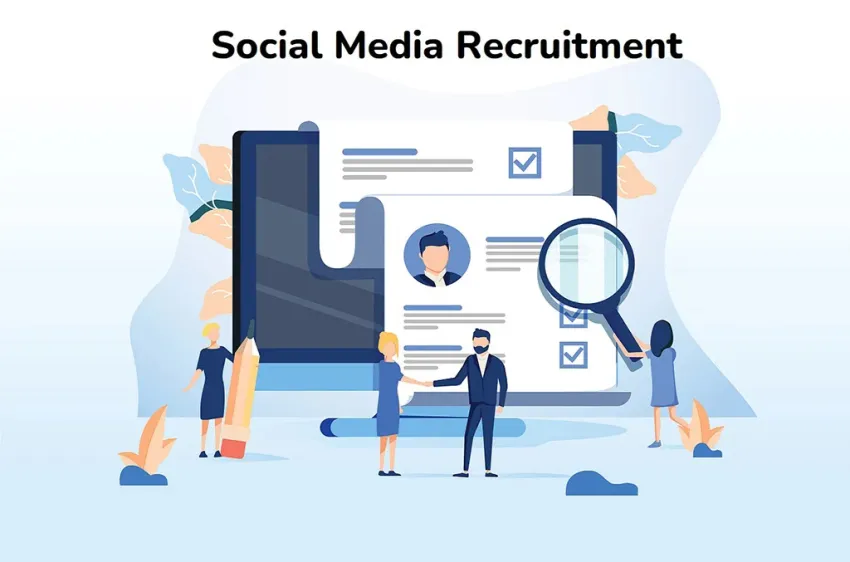
Menu

Menu

When organizations use social media platforms and other internet-based sites such as blogs to search for and engage potential employees, this process is commonly termed social hiring or social media recruitment. Additionally, in many larger HR teams, there are recruitment staff who specialize and are trained specifically in social media recruiting. Furthermore, in addition to searching for employees, social media sites are also extensively used to vet candidates who have applied for advertised vacancies. It has now become standard practice for recruitment teams to search through sites such as Facebook, Instagram, and TikTok to gain a better sense of their candidates before interviewing. Similarly, candidates often include links to their social media accounts on resumes to expand the information, personality insights, and achievement views available to recruiters.

The rise of social media recruiting is closely tied to the increased use of social media by organizations for branding and communication. Furthermore, potential employees are just one of the many groups organizations aim to reach, and social media is an effective way to connect with both active and passive job seekers. In addition, many social media platforms now offer recruitment services, such as job boards and “easy apply” options that link to company websites.
Moreover, candidates can connect with recruiters through unique communication links. Additionally, recruiters use tools to advertise roles, target specific groups, analyze applications, and vet profiles. One of the most popular platforms is LinkedIn, which allows members to indicate availability, search for jobs, apply, and message recruiters directly.
Social media enables recruiters to reach a broader audience in terms of both location and demographics while also allowing targeted campaigns focused on specific groups and requirements as necessary. Moreover, at a time when the use of social media is all-pervasive, organizations have little choice but to embrace this as a key component of their recruitment strategy. The key benefit of using social media platforms for recruitment lies in the technology that powers them.
Additionally, critical features such as powerful search engines, filters, and AI analysis capabilities are a natural fit for the recruitment process. Furthermore, social media facilitates connections with individuals whose profiles suggest they are a strong match for vacant positions. These systems enable checks on all profile elements, including skills, past employment, and education credentials. Many platforms also offer deeper insights into personality and professional standing by showcasing personal activities on the platform, such as posts, likes, group memberships, and endorsements.

In contrast to traditional online job boards or advertisements, which engage active job seekers, social media platforms help recruiters reach passive job seekers who encounter opportunities while browsing or reading and are drawn to the value proposition. Alongside these significant impacts on recruitment effectiveness, social media recruitment is also highly cost-effective compared to traditional methods. Furthermore, cost benefits arise not only from the extended reach and depth of engagement but also from direct comparisons with traditional job fairs or generic advertising.
It is essential that recruiters treat social media as a core part of their recruitment strategy and not just as an add-on to more conventional recruiting methods. As well as requiring a particular skill set in the recruitment team, using social media brings some unique challenges to the process.
♦ ensuring that online social media recruitment aligns with the overall organisational branding. Aligning branding means aligning strategies between corporate communications,
♦ defining plans that maximise the benefits of extended reach with the potential overburdening of recruitment staff from increased volumes of applicants. Whilst targeted recruiting may mean a higher quality of candidate and better alignment with the advertised roles, extending reach without careful planning can also encourage applications from those who may be less qualified and who are submitting mass applications in the hope of getting any job.
♦ using employee and other professional networks effectively alongside the organisation’s more traditional recruitment.

Some social media recruiting mistakes to avoid include:
♦ poor connections from the social media site to the organisation’s application process
♦ failing to take advantage of the social media profile information to auto-complete the application data needed. It is demotivating to have to re-enter numerous pieces of core information on the careers website when the same detail is already available on the social media profile
♦ lack of content consistency on the social media platform versus the organisation’s website
♦ being overly active or inactive with social media communication or being inconsistent pre- and post-application
♦ using too many social media platforms simultaneously so that efforts are diluted and managing the process becomes overwhelming and ineffective.
Just as with any other form of recruitment, it is critical to gauge the success of any campaign and to use the information gleaned to hone the process for the next time.

Some of the most common indicators to use include:
♦ amount of traffic connecting to the organisation’s career page
♦ number of people who engaged on social media and followed through to apply for the vacancy
♦ percentage of applicants meeting the specified qualifications
♦ number of applicants offered positions
number accepting job offers
♦ evidence of engagement (likes, shares and comments) between the organisation and potential candidates.
Using social media for recruitment is now standard practice, and as a result, it is becoming increasingly hard for any organization to attract and retain the right level of talent without embracing these platforms. Furthermore, with the widespread use of social media, organizations must incorporate these tools into their recruitment strategies to remain competitive in the talent market.
The secret to success lies in carefully creating a strategy for using social media. Additionally, it involves aligning messages with the rest of the organization, being selective about which platforms to use, and consistently measuring success. Furthermore, using the lessons learned from previous campaigns is essential to improve future efforts.
Beyond just posting job openings, social media plays a vital role in building and showcasing an organization’s employer brand. In today’s competitive market, candidates aren’t only looking for jobs that fit their qualifications. They also seek companies that align with their values and workplace culture. As a result, communicating your company’s mission, vision, and work environment through social media is crucial. Additionally, sharing employee testimonials, behind-the-scenes content, and success stories can significantly boost your company’s image among potential candidates.
Moreover, branding on social media allows organizations to engage with passive candidates. These individuals may not be actively job hunting but are open to the right opportunity. Thus, platforms like LinkedIn, Instagram, and Twitter become ongoing recruitment tools that nurture talent pools, even when there are no immediate job openings.
Another highly effective trend in social media recruitment is the use of video content. In fact, videos are now one of the most engaging forms of content on platforms like Instagram, TikTok, and YouTube. Furthermore, video enables recruiters to creatively showcase their workplace, provide virtual office tours, or feature quick interviews with employees. These videos give candidates a more personal and immersive view of the company, making the organization much more appealing than static posts or text alone.
Additionally, hosting live Q&A sessions on LinkedIn or Facebook allows recruiters to engage directly with potential candidates in real-time. This not only builds trust but also answers questions candidates may have, helping them feel more connected to the organization right from the start.
While LinkedIn and Facebook remain popular for recruitment, newer platforms like TikTok and Clubhouse are gaining attention. TikTok allows organizations to engage creatively with younger audiences through short, captivating videos that showcase company culture and job opportunities. Its algorithm also helps recruiters reach wider audiences via trending hashtags and challenges.
Similarly, Clubhouse offers recruiters a chance to host discussions and panels about their industries, providing a conversational way to connect with candidates. Participating in these platforms demonstrates an organization’s commitment to staying ahead of communication trends.
Moreover, using these platforms fosters community and builds relationships with candidates before specific vacancies arise. By engaging in discussions, recruiters can position their companies as thought leaders, attracting top talent.
In summary, embracing TikTok, Clubhouse, and other emerging platforms expands recruitment reach and enhances the candidate experience, improving the ability to attract the best talent.
While LinkedIn and Facebook remain popular for recruitment, newer platforms like TikTok and Clubhouse are gaining attention. TikTok allows organizations to engage creatively with younger audiences through short, captivating videos that showcase company culture and job opportunities. Its algorithm also helps recruiters reach wider audiences via trending hashtags and challenges.
Similarly, Clubhouse offers recruiters a chance to host discussions and panels about their industries, providing a conversational way to connect with candidates. Participating in these platforms demonstrates an organization’s commitment to staying ahead of communication trends.
Moreover, using these platforms fosters community and builds relationships with candidates before specific vacancies arise. By engaging in discussions, recruiters can position their companies as thought leaders, attracting top talent.
In summary, embracing TikTok, Clubhouse, and other emerging platforms expands recruitment reach and enhances the candidate experience, improving the ability to attract the best talent.
As social media recruiting evolves, artificial intelligence (AI) improves efficiency by automating tasks like candidate screening, matching, and predicting hiring needs. AI chatbots provide instant answers to candidate questions, enhancing their experience and saving recruiters time.
AI analyzes data to identify trends in candidate behavior, helping recruiters refine sourcing strategies for better matches. Additionally, AI-driven analytics offer insights into post performance, suggesting optimal times and content for engagement.
AI also personalizes communication by tailoring messages based on past interactions, enhancing the candidate experience and strengthening the employer brand.
In summary, leveraging AI in social media recruitment streamlines processes, empowers data-driven decisions, and improves overall recruitment strategies.
Another effective strategy is leveraging user-generated content, which involves showcasing content created by employees or candidates. This approach not only adds authenticity to your employer brand but also fosters trust among potential candidates. For example, sharing videos or testimonials from current employees about their experiences can provide genuine insights into your workplace culture. Furthermore, these authentic voices resonate more with job seekers, as they reflect real experiences and emotions.
In addition, encouraging employees to share their own stories on social media can create a sense of community and attract like-minded candidates. When employees post about their day-to-day experiences, it humanizes the organization and makes it more relatable. Moreover, highlighting diverse perspectives enables organizations to appeal to a broader audience, promoting a more inclusive recruitment strategy. By showcasing different backgrounds and experiences, you can demonstrate your commitment to diversity and inclusion, which is increasingly important to today’s job seekers.
Building a strong online community around your employer brand is essential for successful recruitment. By actively engaging with followers and responding to comments, organizations can create a sense of belonging. This ongoing interaction not only humanizes the brand but also encourages candidates to engage with your content more meaningfully.
Moreover, hosting webinars, workshops, or interactive sessions related to industry topics can position your organization as a thought leader. By sharing valuable knowledge, you can attract potential candidates who are interested in your field, ultimately enhancing your recruitment efforts.
Read about the next step, Employee Onboarding.
Contact us at HRBluSky today to explore how we can support you in implementing your recruitment strategy.
Alignment
Article
Audit
Automation
Benefits
Candidate
Communication
Compliance
Digitalisation
Digital Technology
Diversity
Emirates Id Application
Employee Experience
ESS
Feedback
Health and Safety
HRMS
HR Strategy
HR System UAE
Human Resource Management
Human Resource Management Systems
Job Roles
Learning and Development
Onboarding
Outsource
Payroll
Payroll Management System
Payroll Processing
Performance
Performance Management
Personalisation
Recruit
Recruiting
Recruitment
Remote Working
Rewards
Security
Service Providers
Skills
Smart
Survey
Virtual
Visa Cancellation
Work Environment
Workforce
© 2025 Pruvity HR Solutions Pvt Ltd, Madurai, India